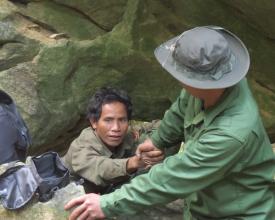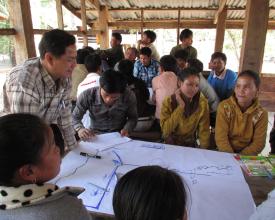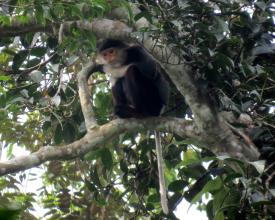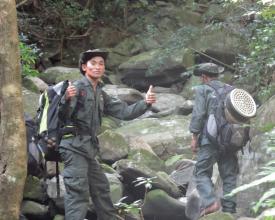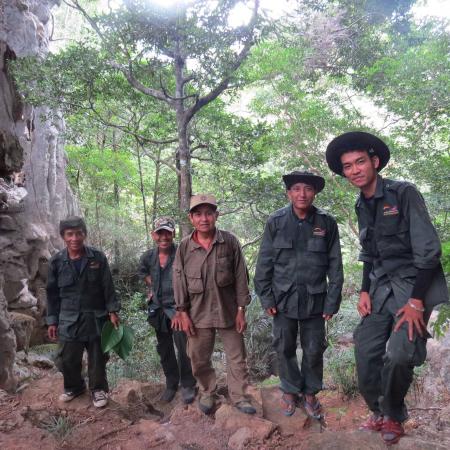
Additional local manpower improves protected area management effectiveness
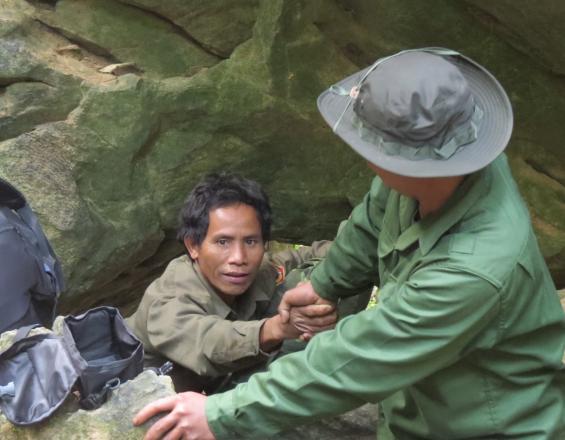
A management unit and co-management structures were set-up involving 244 people from multiple groups of stakeholders (managing the Hin Nam No National Protected Area in Lao PDR). Earlier only 9-12 people worked on the management of the site of 82,000 hectares. Through the additional manpower and knowledge by local villagers, the total management effectiveness score of Hin Nam No NPA increased by 13% in two years. The solution was upscaled in other areas in Laos by the local organisation AFC.
Context
Challenges addressed
lack of law enforcement, knowledge, skills and an insufficient budget make PA management in Laos like a paper park approach due to insufficient budget and human resource allocation by government. Also Hin Nam No has no dedicated management unit with full time staff available and responsibilities are divided over various departments. There is lack of information, law enforcement, capacity, knowledge and skills to effectively manage the PA and monitoring thereof.
Location
Process
Summary of the process
The set-up of the management structure and the drafting of terms of references for the various units by the PA authority helped in the description of the tasks to be done to effectively manage the Hin Nam No PA. As the PA authority could only allocate 2-3 district officials per unit, it became clear that certain tasks needed to be delegated to the local people. This was also confirmed through the governance baseline assessment. So the need for co-management came from the PA authorities and the local people were eager to accept, as they participated in the drafting of co-management agreements outlining clear incentives for their participation, based on customary rights over certain areas. Capacity development of PA authority and villagers enabled them to better execute their tasks. The official endorsement of the vertically coordinated management structure and the co-management agreements by the district governor has legitimized the approach. The 13% increase in management effectiveness after two years has convinced the stakeholders to continue with this partnership. AFC implemented parts of the model in other areas of Laos and replicated certain building blocks by using training materials explaining building blocks in detail.
Building Blocks
Participatory zonation using customary rights and knowledge
Enabling factors
Lesson learned
Local people as additional PA management manpower
Enabling factors
Lesson learned
Governance assessment through participatory consultation
Enabling factors
Lesson learned
Setting up a vertically coordinated management structure
Enabling factors
Lesson learned
Co-management agreements
Enabling factors
Lesson learned
Upscaling of the model
Enabling factors
Lesson learned
Resources
Impacts
Species conservation: Village rangers are set up, trained and capable to work by themselves in patrolling and biodiversity monitoring. Number of wildlife sighted: 2561 (1844 indicator animals). A constant wildlife population and a decline in illegal activities (poaching, illegal logging) could be observed. Benefits for village service providers: 793.000 LAK (baseline) plus 8.8% (37% for women) additional monthly HH income from eco-tourism services for all involved households (35 HH in 4 villages). There is an increase from 465 visitors from the dry season (2013/14) to 2520 visitors in the dry season (2015/16). In 2015 a total of 110 trained village rangers walked 1523 km patrol covering 60% of the park. For this a cost-effective total of 12,000 US$ were paid to the village rangers. Improved management: Increase of 15% in Good Governance score and 13% higher Management Effectiveness score in 2016 compared to 2014. Co-management agreements have been participatory drafted for 19 villages and 5 village clusters and have been agreed and signed during a district follow-up. Thus park management tasks are officially delegated to the villagers of 19 villages. AFC supported three civil society organizations to implement the model elsewhere in Laos (an additional 21 officially approved village co-management agreements, covering 204,747 ha of village forests).
Beneficiaries
Protected Area management authority and surrounding villagers with customary rights
Story

Since village rangers are regularly monitoring wildlife and threats inside the Hin Nam No park, arrests of poachers are becoming more frequent. On Monday 28 July 2014, a team of 8 villager rangers from Ban Dou village carried out their regular forest patrol, when they came across a team of five Vietnamese poachers in the Kuan Nong area. This location is at one day walking distance from the village and three days walking from the Vietnamese border. These poachers had a lot of motorcycle brake wire cables, which are a popular material to make traps as well as explosives and digging equipment. They were looking to dig for the roots of a valuable rosewood type of trees and expecting to trap monkeys and other wildlife to eat. The village rangers arrested the poachers, tied them up with their own wire cables and led them back to the village. The poachers were handed over to the border military station in Ban Dou who kept them for three days. Relevant authorities were called in and a meeting was held to judge the case. The judgment committee decided on a fine to the equivalent of US$3,000, considering that the poachers were caught in the act, but had not collected any illegal timber or wildlife that could be confiscated. The poachers were warned that they were lucky to get the case resolved at the village cluster level. If the case would have been transferred to the province level, the process would have been much longer and the fine at least three times higher. Relatives of the poachers on the Vietnamese side of the border were informed that the poachers were arrested and would only be released once this fine was paid. The relatives arrived within one day and paid the whole fine in cash. The poachers were then released and returned the same day to their hometown of Phong Nha in neighboring Quang Binh Province. The entire process took 4 days. The fine of $3,000 was distributed among the various law enforcement stakeholders. The village rangers who found and arrested the poachers were given a reward of $124 per arrested poacher, totaling $620. Another $200 was spent on the costs of feeding the rangers and their prisoners. The remaining sum of $2180 was divided equally between officials of the local village cluster of Ban Dou and the District Park Authority.

